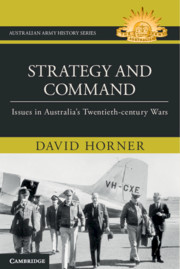Book contents
- Strategy and Command
- Other titles in the Australian Army History Series
- Acknowledgement of Country
- Strategy and Command
- Copyright page
- Contents
- Figures, maps and tables
- Preface
- Acknowledgements
- Abbreviations
- Introduction
- Chapter 1 The influence of the Boer War on Australia’s First World War commanders
- Chapter 2 Preparing for war, 1901–14
- Chapter 3 The AIF’s commanders
- Chapter 4 Strategic planning between the wars
- Chapter 5 Identifying the threat from Japan in 1941
- Chapter 6 A pivotal year in Australian history: 1942
- Chapter 7 Australia and coalition warfare in the Second World War
- Chapter 8 Deciding Australia’s war strategy in 1943
- Chapter 9 Advancing national interests
- Chapter 10 Higher command in the Korean War
- Chapter 11 Higher direction of the army in the Vietnam War
- Chapter 12 The Gulf War, 1991
- Chapter 13 Deploying and sustaining INTERFET in East Timor in 1999
- Chapter 14 Developing a command structure for joint operations
- Notes
- Bibliography
- Index
Chapter 11 - Higher direction of the army in the Vietnam War
Published online by Cambridge University Press: 08 October 2021
- Strategy and Command
- Other titles in the Australian Army History Series
- Acknowledgement of Country
- Strategy and Command
- Copyright page
- Contents
- Figures, maps and tables
- Preface
- Acknowledgements
- Abbreviations
- Introduction
- Chapter 1 The influence of the Boer War on Australia’s First World War commanders
- Chapter 2 Preparing for war, 1901–14
- Chapter 3 The AIF’s commanders
- Chapter 4 Strategic planning between the wars
- Chapter 5 Identifying the threat from Japan in 1941
- Chapter 6 A pivotal year in Australian history: 1942
- Chapter 7 Australia and coalition warfare in the Second World War
- Chapter 8 Deciding Australia’s war strategy in 1943
- Chapter 9 Advancing national interests
- Chapter 10 Higher command in the Korean War
- Chapter 11 Higher direction of the army in the Vietnam War
- Chapter 12 The Gulf War, 1991
- Chapter 13 Deploying and sustaining INTERFET in East Timor in 1999
- Chapter 14 Developing a command structure for joint operations
- Notes
- Bibliography
- Index
Summary
The Australian Army’s commitment to the Vietnam War between 1962 and 1972 had much in common with its commitments to previous wars. Again the issues of strategy and command were important. In the Boer War, the two world wars, Korea, Malaya and Malaysia, Australian Army formations and units came under the operational control of an allied commander. Australia had little say over the higher strategic direction of the war or indeed over the strategy employed within each theatre of war. The main exception to that pattern was in the South-West Pacific Area between 1942 and 1944 when the Allied commander-in-chief, General Douglas MacArthur, was based in Australia and discussed his strategic plans with the Australian Government, although ultimate direction came from the Combined Chiefs of Staff in Washington. Furthermore, the Commander of the Allied Land Forces, General Sir Thomas Blamey, had a measure of independence in determining how and where the units of the Australian Army would fight.
- Type
- Chapter
- Information
- Strategy and CommandIssues in Australia's Twentieth-century Wars, pp. 194 - 220Publisher: Cambridge University PressPrint publication year: 2021

